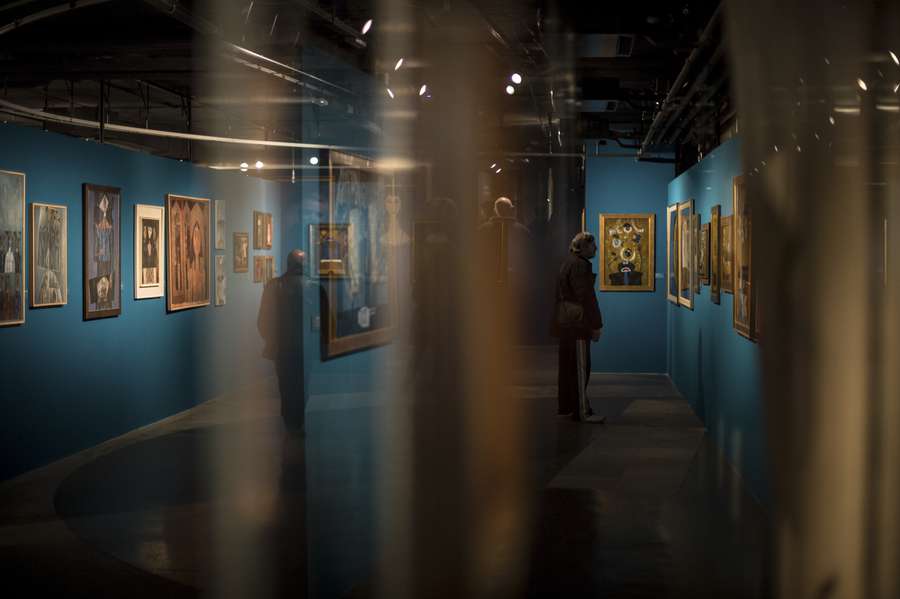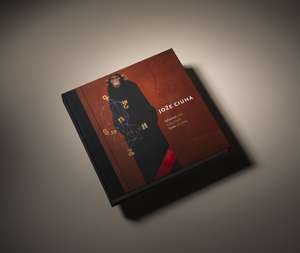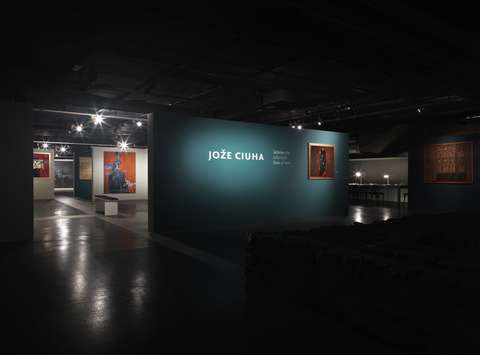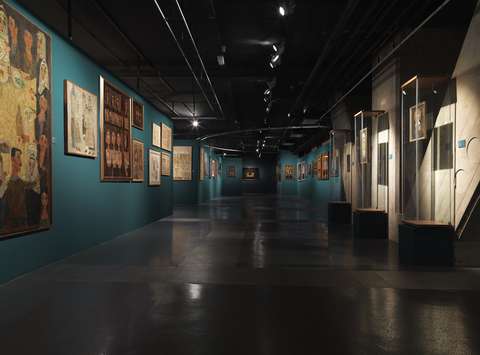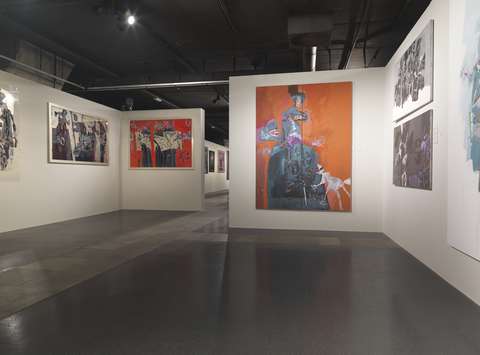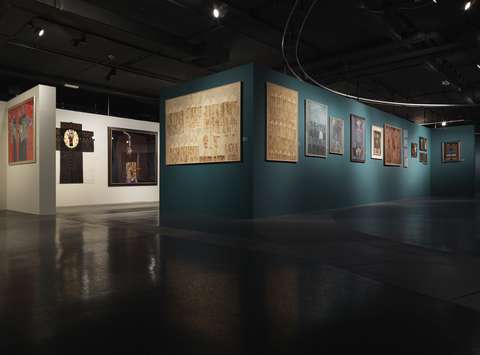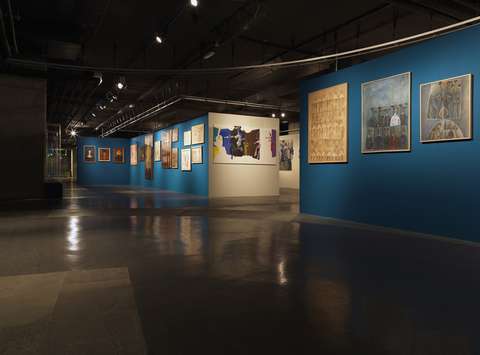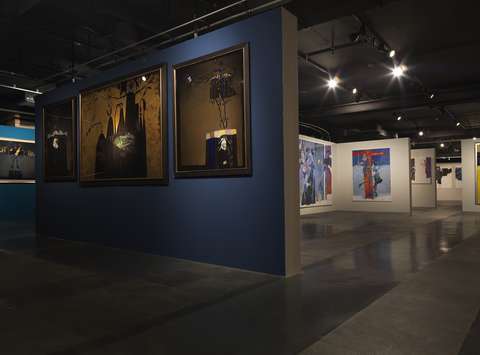Jože Ciuha: The Labyrinth of Time
On the 90th anniversary of the renowned Slovene academic painter Jože Ciuha's birth, the Jakopič Gallery is presenting a retrospective exhibition of his works. His diverse creativity has left an indelible mark on almost seven decades of Slovenian art.
"Staging a retrospective show was a great challenge for the Jakopič Gallery. The artist’s oeuvre is extremely extensive and varied, containing many important highlights, and the Gallery's spatial capacities are limited. I do believe, however, that we have risen to the challenge. Moreover, we invited the artist himself to actively participate in preparing the exhibition," said the curator Marija Skočir.
By reviewing the past and looking back to the beginnings, with its radical selection the exhibition aims to shed light on certain aspects and circumstances that have decisively affected the reception of Ciuha’s body of work; highlight its peaks; contemplate the cycles of motifs and forms and round them off; and reminisce about the author’s experience of the second half of the 20th century. The earliest work to be exhibited, i.e. Self-portrait (ink drawing), dates back to 1945. The exhibition thus presents the oeuvre the artist started to create in the mid-20th century, showcasing both drawings and paintings created from the 1950s on, highlighting works from the 1967 to 1981 period, and displaying them alongside the large formats painted in the most recent years. The exhibition has been designed as an open-ended exhibition, thus abiding by Ciuha’s life principle that "his best painting is yet to be painted".
In the accompanying catalogue, Barbara Savenc wrote: "Today, Ciuha is best known for his paintings and prints into which he has managed to transpose his vision as a painter. In order for this vision to emerge, it was necessary that the artist had first gained fame as an illustrator and then, from the 1960s on, had asserted himself as a drawer creating a series of travel drawings. The fact that the latter – from Paris and Burma – are far from being only some fleeting and marginal sketches becomes clear as soon as the viewer has paid his entire attention to them. /…/ Ciuha’s paintings based on a well-engineered framework were upgraded with certain formal solutions that he had first applied in what are termed "instant techniques", such as drawing and watercolour (the latter only in the final decades of the 20th century)".
Both the exhibition and the catalogue also aim to shed light on the artist’s specific spiritual and philosophical background that he has built mainly on the experiences gained on his travels. The earliest mark left on him was that of Macedonia, and later on of the Buddhist East. According to Marija Skočir: "From his experience of Buddhism, Ciuha took on an internalised and unresisting awareness of the existence of internal silence and meditative emptiness, which form the only proper basis for the emergence of new creative energies. The possibility of personal free choice turned perception towards the everyday material world, where “in the covert apocalyptic ride of the present time, man's spiritual profile is defined by his competitors by means of a chronometer and a chord”. However, it is his home environment where he grew up and which he was later leaving, but nevertheless kept returning to, that is the only true home for him: “Yet I have to confess to be acclimatised to this spiritual atmosphere. It is only this one that the guidelines of my spiritual existence adhere to".
The retrospective exhibition The Labyrinth of Time is accompanied by an extensive and comprehensive catalogue containing reproductions of over 200 works. Three expert texts describe in detail and reflect on the artist’s creative life, illuminating the process of creating this extensive oeuvre, its reception and the role played in the context of Slovenian art. The three authors, art historians of the younger generation, i.e. Barbara Savenc (MGML), Marija Skočir (MGML) and Marko Košan (Koroška Gallery of Fine Arts), were capable of dealing with Ciuha’s works from an unproblematic point of view which, given the length of time in which Ciuha has been creating, allows for the necessary time distance. Participating in the preparation of both the catalogue and the exhibition was the Koroška Gallery of Fine Arts from Slovenj Gradec, which will host the exhibition at the beginning of 2015. A foreword to the catalogue was written by the Minister of Culture, Dr Uroš Grilc.
ABOUT THE ARTIST
Jože Ciuha was born on 26 April 1924 in Trbovlje. When he was four, the family moved to Videm, a village in the Krško municipality. He began school in 1930. Having enrolled in the first public ‘non-classical’ secondary school in 1936, he moved to Ljubljana to stay with his aunt. Following the outbreak of the war, he had to return to his parents. During World War Two, he was forcibly mobilised into the German army in 1943. While staying in a small town in Normandy, he nevertheless managed to desert and joined the allied forces. After a traumatic journey home, he eventually arrived in Split where he disembarked as a soldier of the 5th Overseas Brigade. In 1944, he joined the Partisans, where he was active in the field of culture. After the war, Ciuha first enrolled in the Faculty of Arts to study comparative literature, art history and archaeology. Despite his enthusiasm for literature and art, his impulse to create was stronger. In 1946 he passed his entrance examination at the Ljubljana-based Academy of Fine Arts and, after graduating in 1950, continued his studies in a postgraduate wall-painting class under Slavko Pengov. While a postgraduate student, he also taught at the Bežigrad Grammar School and was a prolific illustrator.
A considerable part of his life is crucially marked by travels, of either an educational or personal nature, which he himself refers to as “a nomadic addiction”. As a student, he visited Ohrid in Macedonia where he discovered the world of monumental frescos and the wealthy Byzantine heritage, which profoundly influenced his creativity. In 1949 he married for the first time, with his daughter Marjetka being born a year later. Ciuha left for Paris as a freelance artist in 1956, staying there for seven months. According to Ciuha himself, Paris reinvigorated him spiritually, significantly broadening his horizons. After returning home, he spent some time in Ljubljana. In 1959, he fulfilled a promise he had made over a decade before – a journey to the East. He thus set off on a study trip to Rangoon, Burma, where he intensely researched Eastern and Buddhist philosophy and spirituality. Along with Burma, Ciuha toured Thailand, Cambodia, Indonesia, Bangladesh and India. In Rangoon he staged an exhibition showcasing the works created there, and described his travels in the travelogue Okameneli smehljaj (A Petrified Smile). Back home, he lived between Ljubljana and Poljane nad Škofjo Loko in the studio of his friend Ive Šubic. He married Radmila Novak in 1962. In 1964, he set off for South America, visiting Brazil, Argentina, Chile, Peru and Bolivia, where he encountered ancient Indian cultures; the book entitled Pogovori s tišino (Talking to Silence) was written during this journey. After having spent the next year in Sweden, he was invited to the Western Michigan University in Kalamazoo, USA, in 1966. He there worked in a large studio at the Institute of Arts, and lectured on Buddhist art. Later he toured the USA and Mexico together with his wife. Soon after they returned home in 1968, their son Peter was born.
Despite his many travels, it was Paris that Ciuha constantly returned to, eventually moving there in the 1980s. After having started to exhibit his works, he soon met the poet and art critic Alain Bosquet. It was with the help of Bosquet that the door to the art world of Paris was opened for Ciuha. He obtained a new studio and was invited to put on several prestigious exhibitions around the world. For more than three decades, he has been living between Ljubljana, where his family lives, Paris, and the island of Šipan, where he mostly works during the summer months.
The creativity of Jože Ciuha also includes teaching, which he has been doing lately in cooperation with his son Peter, as well as collaborations with other artists. In 1969 he was one of the artists who, on the initiative of Zoran Kržišnik, co-founded Group 69, which involved “artists of different generations, different aesthetic views and different artistic expressions”, their main purpose being annual exhibitions with foreign artists invited by the members to participate. He often worked as a teacher – in the late 1950s at the Bežigrad Grammar School, in the 1970s he ran a painting seminar at the International Summer Academy in Salzburg, and lectured at the Western Michigan University, then taught graphic art at the International Graphic School in Venice for two years and lectured at the Academy of Fine Arts in Ljubljana. But, despite his teaching activities, Ciuha remains one of the few Slovenian artists to have been active primarily in the creation of art.
The creativity of Jože Ciuha has been committed to various art techniques, seasons of the year and, in particular, to the environment in which he creates. His watercolours, "the monologues of his intimate world", are mostly created during his summertime stays on the island of Šipan, graphic prints are made in both Ljubljana and Venice, whereas paintings, "his dialogue with the world and the time", are a product of all times and seasons. He is also involved in drawing, illustration, the creation of mosaics and tapestries. In addition, Ciuha is a poet and a writer. His works have been presented in numerous solo (almost 300) and group (over 500) exhibitions both locally and abroad, hosted by several renowned galleries. His works can be found in major international arts institutions. Ciuha has received many awards. In Slovenia, mention should be made of the Prešeren Fund Award, the Levstik Award and the Župančič Award. Abroad, he was awarded the Order of Arts and Letters and the Austrian State Prize, and granted honorary membership of the Russian Academy of Arts in Moscow. (Summarised from the artist's biography published in The Labyrinth of Time catalogue, MGML, 2013, collected and edited by Nika Perne)
The retrospective exhibition "Jože Ciuha: The Labyrinth of Time" is accompanied by an extensive and comprehensive catalogue containing reproductions of over 200 works.
Colophon
Production: Museum and Galleries of Ljubljana
Artist: Jože Ciuha
Curator: Marija Skočir, Barbara Savenc
Graphic and exhibition design: Bojan Lazarevič - Agora Proars
Realisation of the exhibition: Technical Service MGML, O.K.vir
The project was made possible by: City of Ljubljana, Ministry of Culture of the Republic of Slovenia
Location
Slovenska cesta 9
1000 Ljubljana
T +386 1 42 54 096
T +386 1 24 12 500
E galerija.jakopic@mgml.si
Opening hours
Tuesday–Sunday: 10 a.m.-6 p.m.
Monday: Closed
1 January, 1 November, 25 December: Closed
24 and 31 December: 10. a.m.-2 p.m.
Tickets
Adults: 5 €
Students, people over the age of 60, unemployed, people with disabilities: 3 €
Family ticket: 12 €
ICOM, PRESS, SMD, students of the Academy of Fine Arts and Design, VIST – Higher School of Applied Sciences, Faculty of Natural Sciences and Engineering – OTGO, Faculty of Design: Admission free
Guided tours of the exhibition: every Saturday at 4.30 p.m. (included in the admission fee)
Join the Friends of the Jakopič Gallery. The € 12 annual membership fee includes numerous benefits and exclusive events. Click here for more information.
